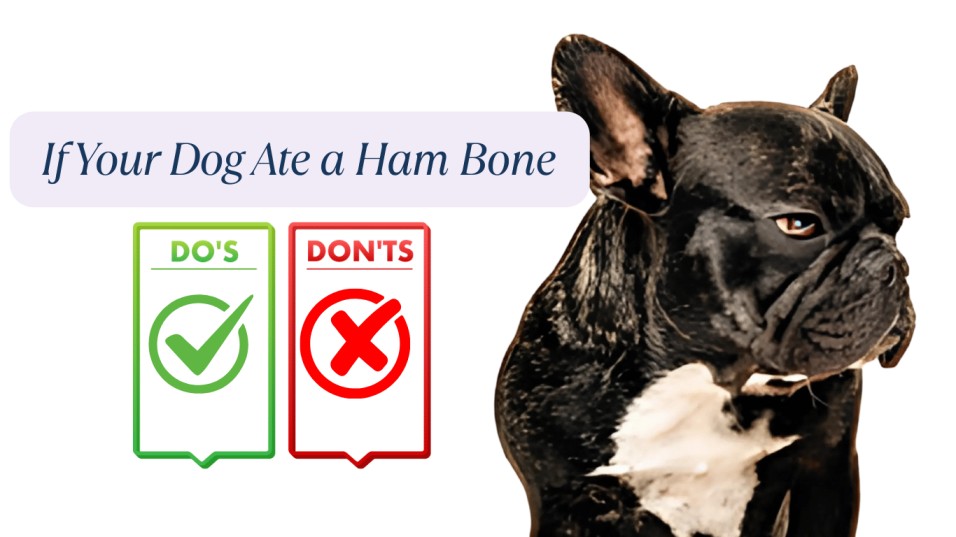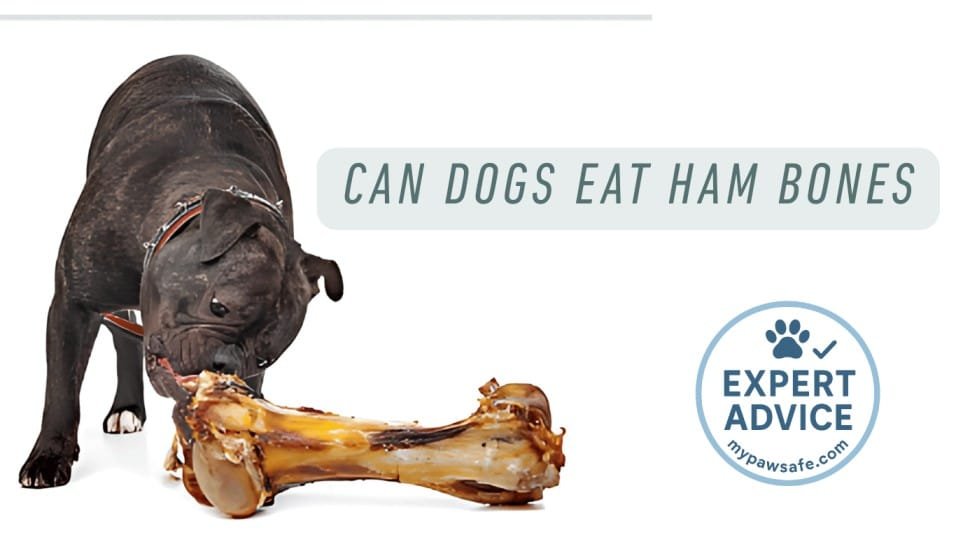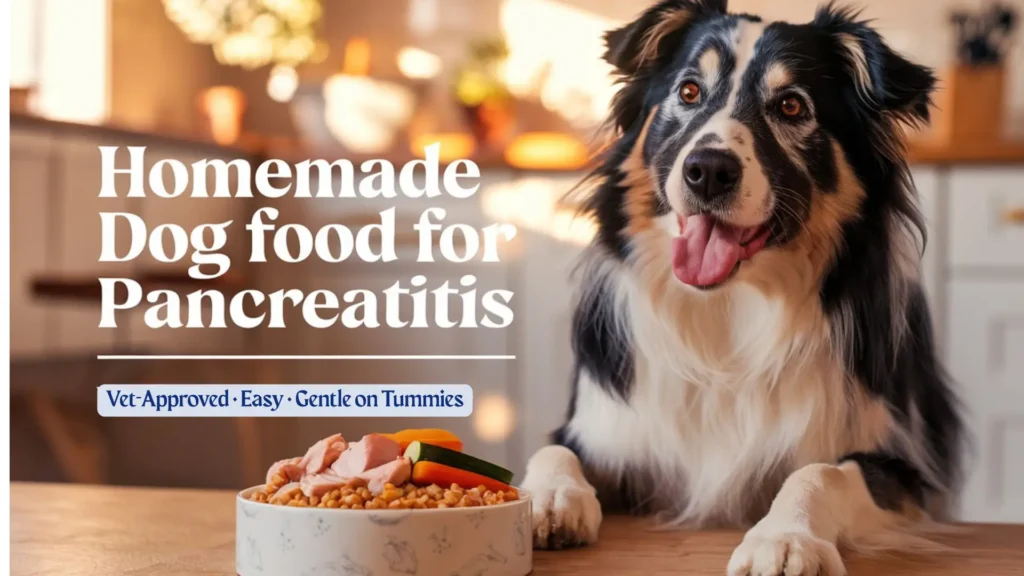I used to think so. One holiday, I gave my German Shepherd a ham bone as a treat. A few hours later, we were rushing to the vet. That moment changed how I see dogs and ham forever.
In this post, I’ll share what I learned, what my vet said, and what I do now. If you’ve ever asked yourself, “Should dogs eat ham bones?”—you’re not alone.
Table of Contents
Can Dogs Eat Ham Bones? What I’ve Learned as a Dog Owner
I used to think the answer was yes. It felt natural—dogs love bones, right? But after one scary night with my German Shepherd, I found out the hard way that ham bones can be dangerous for dogs.
The truth is, dogs should not eat ham bones. Cooked bones—especially ones from ham—can splinter fast. These sharp bits can hurt your dog’s throat, block their belly, or worse. I had no idea at the time. I just thought I was giving my dog a treat.
That night, he seemed fine at first. But then he started acting off—panting, pacing, and not wanting to lie down. It was a gut punch. I rushed him to the vet, feeling both scared and guilty. The vet told me something I’ll never forget: “Cooked bones are one of the most common causes of emergency visits for dogs.”
Since then, I’ve changed how I feed treats. No more ham bones. No matter how much my dog begs or how tasty it looks, it’s just not worth the risk. If you’re ever unsure, the best move is to skip it or ask your vet.
Should Dogs Eat Ham Bones?
No, dogs should not eat ham bones. Even if they beg for one, the risk just isn’t worth it.
Ham bones can splinter easily once cooked. These sharp pieces can get stuck in your dog’s throat or cause damage as they pass through the digestive tract. In some cases, they can lead to choking, intestinal blockages, or tears in the stomach lining. That’s why vets strongly advise against giving cooked ham bones to dogs.
I learned this lesson the hard way. One Christmas, I gave my German Shepherd a leftover ham bone, thinking he’d enjoy it like a chew toy. At first, he was thrilled. But a few hours later, he started acting weird—restless, licking his lips, and refusing food. Turns out, a small splinter had lodged in his throat.
We ended up at the emergency vet at midnight. The bone had caused irritation and needed to be removed. Thankfully, he recovered, but the vet told me we were lucky. Many dogs suffer serious injuries from ham bones.
So, when someone asks, “Can dogs eat ham bones?”, my answer is simple: Don’t risk it. There are safer, healthier options out there that your dog will love just as much—without the emergency room visit.
Why Ham Bones Are Risky for Dogs
Both cooked and raw ham bones are risky for dogs. While many believe raw bones are safer, ham bones—whether raw or cooked—can still splinter and hurt your dog.
Let’s talk cooked bones first. Cooked ham bones are brittle. When chewed, they break into sharp shards. These can poke your dog’s gums or, worse, slice their throat or stomach. That’s exactly what happened with my German Shepherd. I had no idea a holiday treat could send us straight to the ER.
Now, raw bones aren’t much better. Raw ham bones can carry bacteria like Salmonella or E. coli. And because ham is a fatty meat, even raw bones can upset your dog’s stomach. Some dogs might seem fine at first, but problems can show up hours—or even a day—later.
Here’s a breakdown of the main risks:
- Splintering hazard: Cooked bones snap like dry sticks. Even raw ones can crack with enough force. These pieces can stab your dog’s insides or get lodged along the way.
- Choking or blockage: Big chunks can get stuck in the throat or intestines. Some dogs need surgery to remove them.
- Bacterial contamination: Raw pork products carry harmful germs. A tough stomach doesn’t always mean your dog’s immune system is ready for that.
When I brought my pup to the vet, she didn’t sugarcoat it. “Ham bones are one of the worst kinds,” she said. “They’re fatty, salty, and dangerous—pretty much a triple threat for dogs.” That stuck with me.
So if you’re wondering, “Can dogs eat cooked ham bones?” or “Should dogs eat ham bones at all?”—my honest answer is still no. Even with supervision, it’s like letting your dog play with a loaded mousetrap. Sooner or later, something’s going to snap.
Is Ham OK for Dogs? The Meat vs. the Bone
Ham isn’t toxic to dogs, but it’s not exactly safe either—especially in large amounts or with bones. A tiny piece now and then might be fine, but even that comes with some big red flags.
Let’s start with the meat itself. Ham is salty, fatty, and often full of preservatives. Most store-bought ham is processed, which means it’s loaded with sodium and nitrates—stuff that doesn’t belong in a dog’s bowl. Even a small piece can upset a dog’s stomach or lead to pancreatitis in sensitive pups. My German Shepherd once snagged a bit of ham off the counter (classic move), and sure enough—he had loose stools for two days.
Now, some people ask, “Is ham okay for dogs in small amounts?” Technically, a bite of plain, cooked ham with no seasoning or bone can be safe for some dogs. But it’s a treat that should be rare—like birthday-level rare. Even then, it’s best to keep portions tiny and infrequent.
But I’ll be honest—I just don’t give ham anymore. After what happened with the bone and seeing how even the meat upset my dog’s stomach, it’s not worth the gamble. There are so many better treats out there that don’t leave me nervously watching him for signs of stomach trouble. If I’m not 100% confident it’ll sit well with him, I skip it.
So, is ham okay for dogs? In very small, plain amounts—maybe. But between the salt, fat, and processing, it’s one of those foods I’ve personally crossed off the list. I’d rather stick to treats I know are safe and won’t come with a side of guilt.
What to Do If Your Dog Ate a Ham Bone
So, your dog ate a ham bone. What now? First, don’t panic. But don’t ignore it either. Ham bones can be dangerous, so act fast.

Step 1: Watch for Symptoms
Even if your dog seems okay, keep an eye on them. Problems can show up later. Look for:
- Vomiting
- Tiredness
- Trouble pooping
- Bloody stool
- Drooling or licking lips a lot
- Signs of pain (whining, pacing, refusing to lie down)
If you see any of these, move to the next step.
Step 2: Call Your Vet
If your dog ate a ham bone, calling the vet is smart. They will ask about your dog, the bone, and any symptoms. Then, they’ll tell you what to do next.
Call right away if:
- Your dog is choking
- They seem very weak
- There’s blood in vomit or stool
These are emergencies. If your vet isn’t open, go to an emergency animal clinic.
Step 3: Look for Danger Signs
When my German Shepherd ate a ham bone, he seemed fine at first. But after a few hours, he started pacing and wouldn’t settle down. He kept licking his lips, which I later learned was a sign of nausea. Then, he refused food. That’s when I knew something was wrong.
At the vet, they found a bone splinter stuck in his throat. Thankfully, they got it out before it caused more damage. But I’ll never forget how scared I felt.
Step 4: Vet Treatment
If your dog ate a ham bone, the vet might:
- Make them vomit (only if it’s safe)
- Take X-rays to check for blockages
- Do surgery if a bone is stuck
- Give medicine to help digestion and prevent infection
For my dog, the vet used a tool to remove the splinter. If I had waited longer, it could have caused a serious infection.
Final Thought: Act Fast
If your dog ate a ham bone, don’t wait for things to get worse. The sooner you act, the better. And if you’re unsure, call your vet. It’s always better to be safe than sorry.
Safe Alternatives to Ham Bones
Ham bones are a no-go. But what can you give your dog instead? Good news—there are safe, vet-approved options that your pup will love.
Vet-Approved Chew Options
Raw Bones (With Caution)
Raw bones are safer than cooked ones, but not all are good. Choose large, raw beef or bison bones. They don’t splinter as easily and have healthy minerals. But always watch your dog—raw bones can still cause tooth breaks or tummy troubles.
Dental Chews
Need a bone-like treat? Dental chews work great! Brands like Greenies or Whimzies clean teeth while satisfying chew cravings. Plus, they digest easily—unlike real bones that can block the intestines.
Rubber Chew Toys
Sometimes, the best chew isn’t food. Tough rubber toys, like a Kong filled with peanut butter, last for hours. They keep dogs busy and stop them from chewing things they shouldn’t. My German Shepherd loves his Kong—it’s a lifesaver on rainy days.
What I Now Give My German Shepherd
After my scary experience with ham bones, I switched to safer treats. Now, I stick to:
- Raw marrow bones (only with supervision)
- High-quality dental chews
- Rubber and nylon chew toys
- Frozen carrots (a crunchy, natural treat!)
These make him happy—without emergency vet visits. His teeth stay clean, and his digestion is much better.
Why Switching is Worth It
Since ditching ham bones, I’ve noticed big improvements. Here’s why:
- No tummy troubles – No splinters, blockages, or pain.
- Healthier teeth – Dental chews and raw bones fight plaque.
- Less stress for me – No more worrying about hidden dangers.
- Longer-lasting fun – A Kong with peanut butter keeps him busy way longer than a bone!
Final Thought: A Safe Dog is a Happy Dog
Giving your dog a bone feels like a classic move. But after my German Shepherd’s emergency, I won’t risk it again. There are so many safer, better chew options. If you need ideas, now you have plenty! Your pup will love them, and you’ll have peace of mind knowing they’re safe.
Final Thoughts – Why I Say “No” to Ham Bones for My Dog
No, I don’t feed ham bones to my dog.
I learned the hard way that if I wouldn’t eat it with confidence, I shouldn’t feed it to my dog. My experience taught me that ham bones can lead to painful vet visits and worry. I now stick to safer treats and trust my vet’s advice.
It’s best to play it safe with dog treats.
I always remind myself: if it feels risky for me, it’s too risky for my dog. Seeing my pup in discomfort made me change my habits. Today, I choose treats that make both of us feel good and keep our days stress-free.
Always consult with your vet about new treats.
I encourage all dog owners to check with a vet before trying new foods or treats. Sharing my story, I hope you find it helpful and feel confident in choosing safe options for your furry friend. A little extra care goes a long way in keeping them happy and healthy.
FAQ:
Can dogs eat small pieces of ham?
Small, plain pieces of ham are not toxic but are high in salt and fat, which can cause stomach upset or pancreatitis. It’s best to avoid feeding ham to dogs.
Are there safe alternatives to ham bones?
Yes, try raw marrow bones (with supervision), dental chews, rubber toys like Kong, or frozen carrots. These are safer and healthier for dogs.
Can cooked bones be given to dogs in any form?
No, cooked bones of any kind, including ham bones, become brittle and can splinter, leading to serious health risks like choking or intestinal tears.
What’s the safest way to satisfy a dog’s chewing instinct?
Use vet-approved options like durable chew toys, raw marrow bones (supervised), or dental treats designed to promote oral health without risks.
Should I consult my vet before giving my dog new treats?
Yes, always check with your vet before introducing new foods or treats. They can help ensure what you choose is safe and suitable for your dog.

We’re the dedicated team behind MyPawSafe.com, with over a decade of combined experience in veterinary care, pet emergency response, and animal behavior. While we prefer to let our work speak for itself, our mission is clear: to provide science-backed, vet-approved advice that helps pet owners prevent accidents and save lives.



